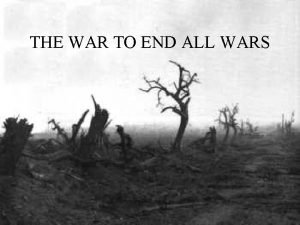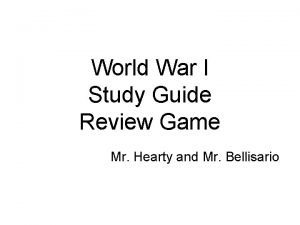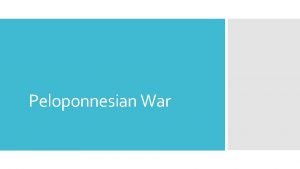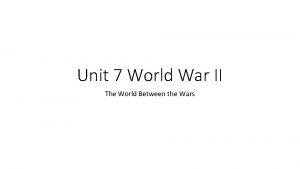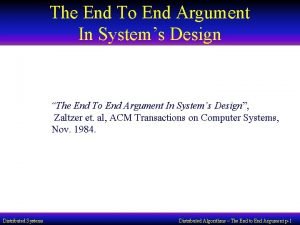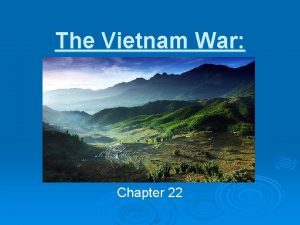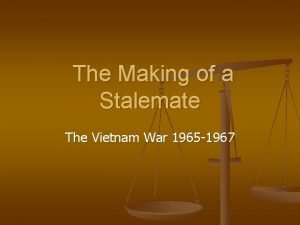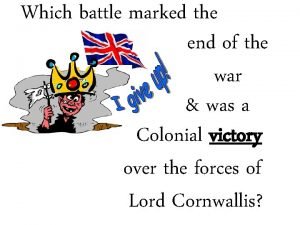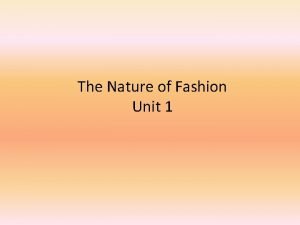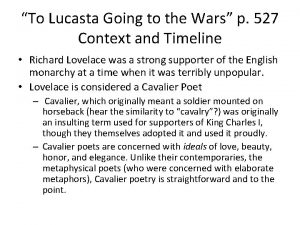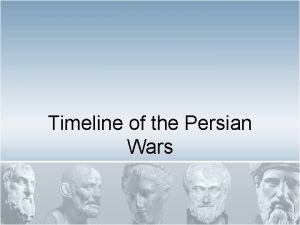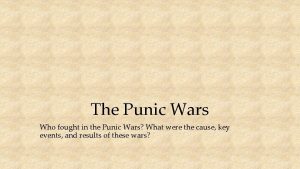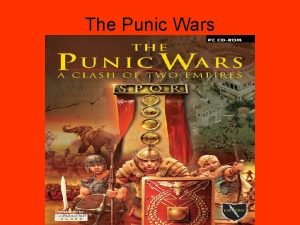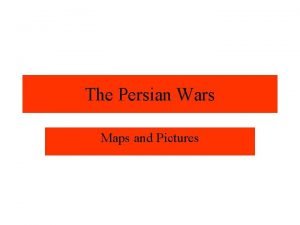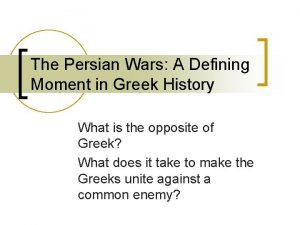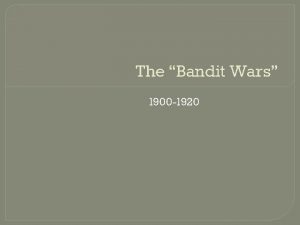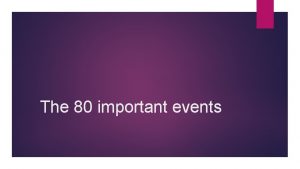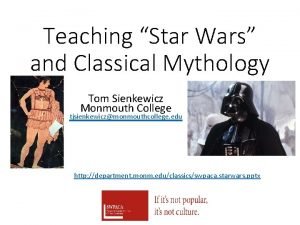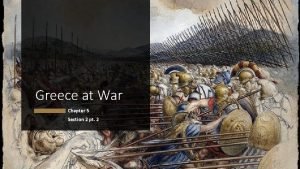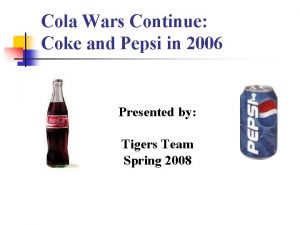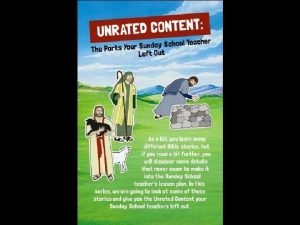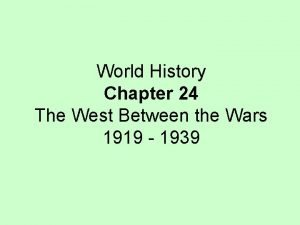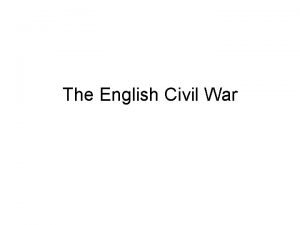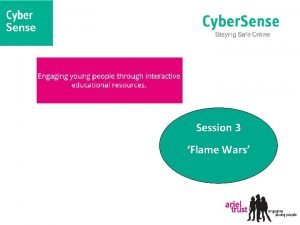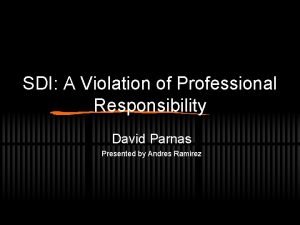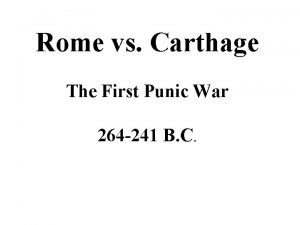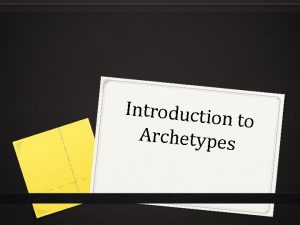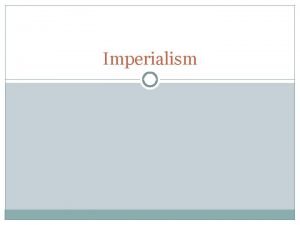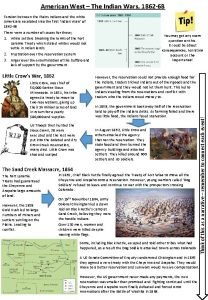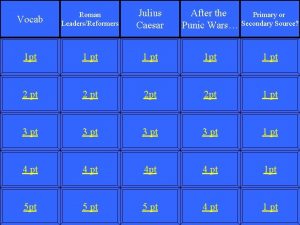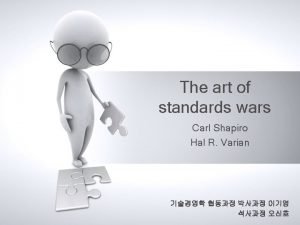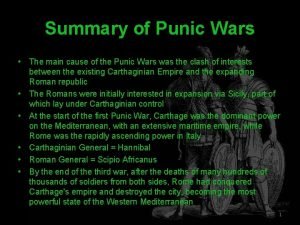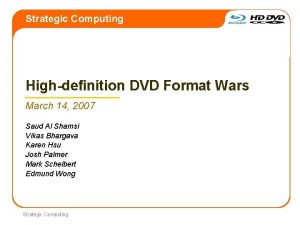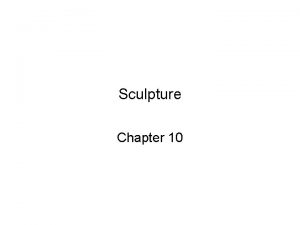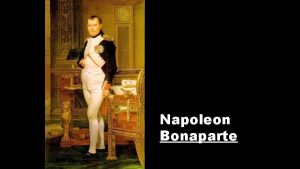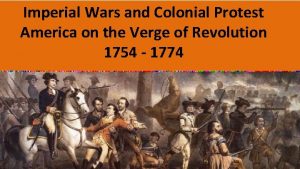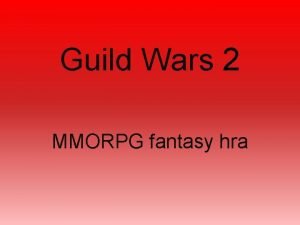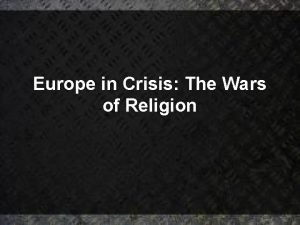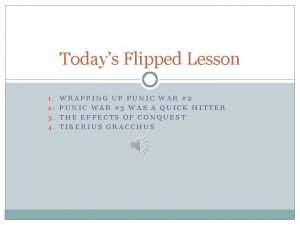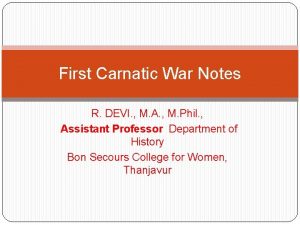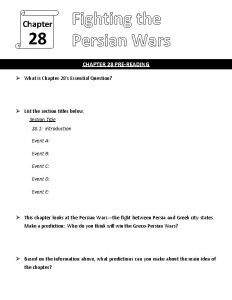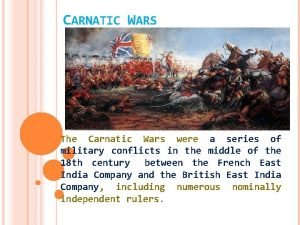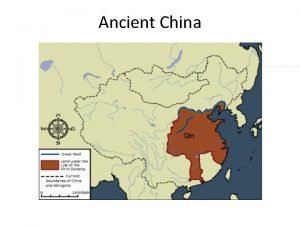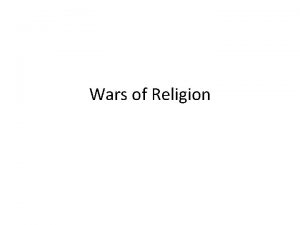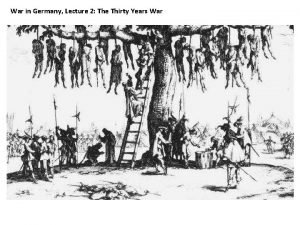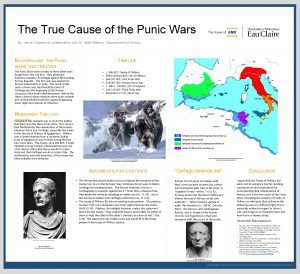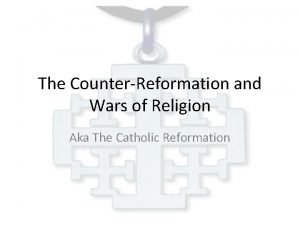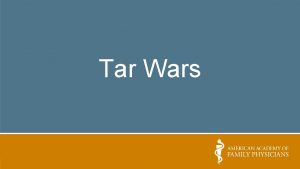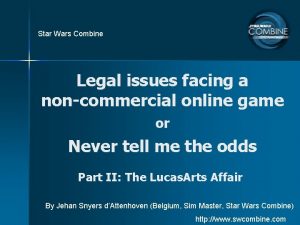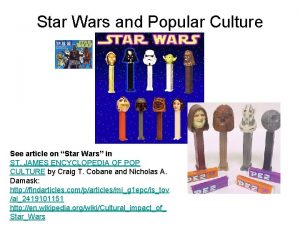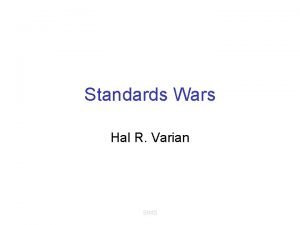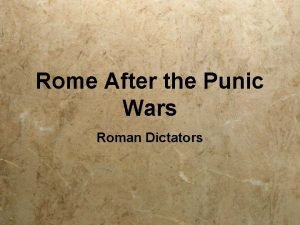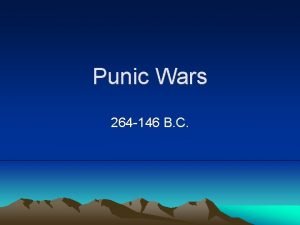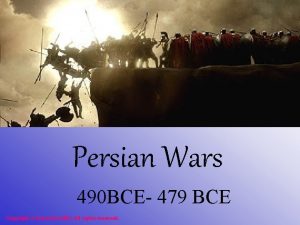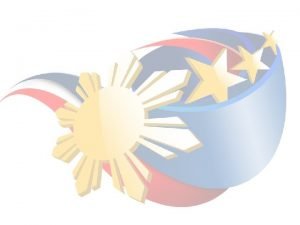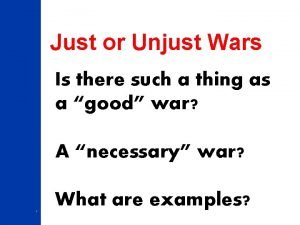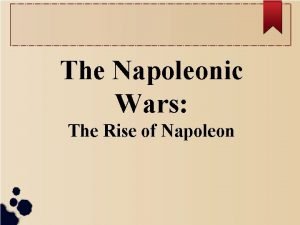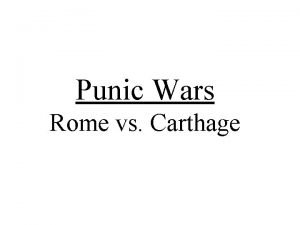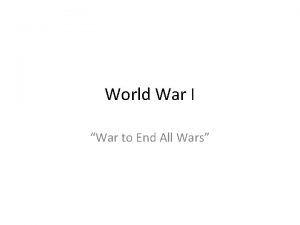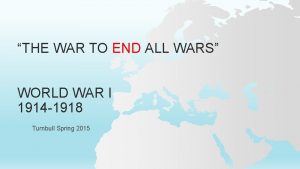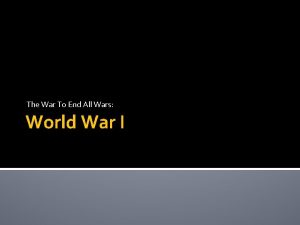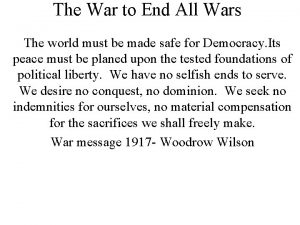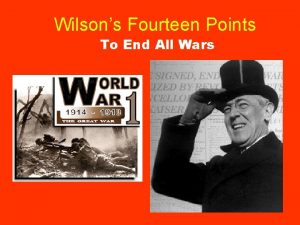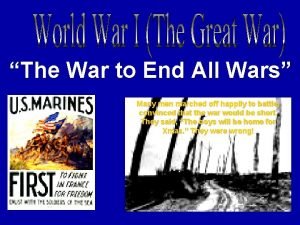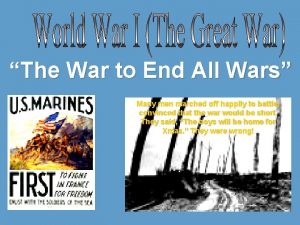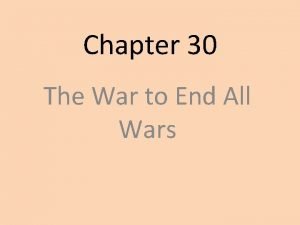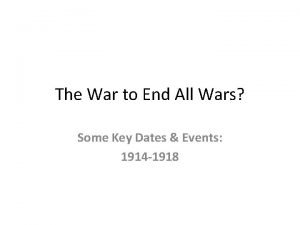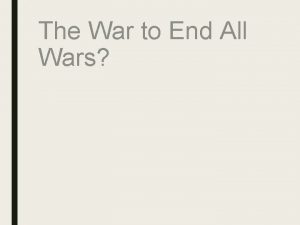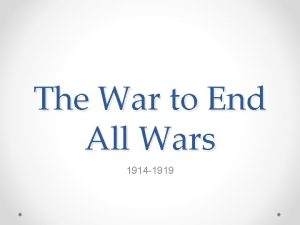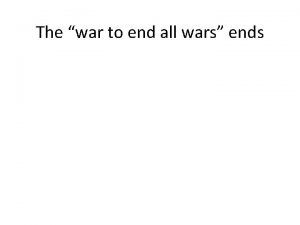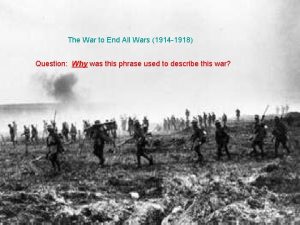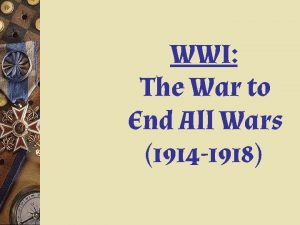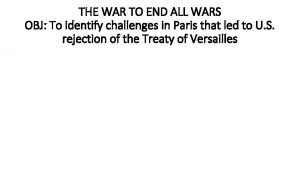World War I War to End All Wars









































































































- Slides: 105

World War I “War to End All Wars”

The Causes • Militarism • Alliances • Imperialism • Nationalism

Militarism European Countries were building up their militaries to compete with each other 1880 • Germany • France • Russia 1914 1. 3 m 5. 0 m 0. 73 m 4. 0 m 0. 40 m 1. 2 m

Causes of WWI Triple Entente: Great Britain France Russia - Alliances Triple Alliance: Germany Austria-Hungary Italy

Imperialism All the great powers were competing for colonies / territory. “Race” to Colonize Africa Colonization in Asia

Alliances • The alliance system in Europe started with Prussia • Prussia wanted to unite the German states into a German nation • Germany united (allied) with Austria-Hungary and Italy • France and Germany were enemies and so France allied with Russia

Alliances • Great Britain remained neutral until Germany started to build up its navy • Great Britain loosely allied with France and Russia forming the Triple Entente • Nationalism – intense pride for one’s homeland was a powerful idea in Europe • Self-determination – the idea that people who belong to a nation should have their own country and government, was a basic idea of nationalism

Alliances

• Pride in one’s country or culture • Self Determinationgovernment run by its own people Serbia’s national flag

Alliances • A small country called Serbia, allied with Russia, wanted a unified Balkan nation • A Serb national assassinated Archduke Franz Ferdinand • This assassination forced Austria-Hungary to declare war with Germany siding with them • Russia, allied with Serbia, declared war with France siding with them (France wanted Germany defeated)

“Balkan Powder Keg” • In the Balkans, many ethnic groups fought to gain political unity and self-rule • This led to conflicts between Austria-Hungry and neighboring groups in the Balkan regions – Russia supports “Serbs/Slavs” • This will end up being the “straw that breaks the camel back” – Assassination of Archduke Ferdinand


Spark: Assassination of Archduke Ferdinand of Austria-Hungary

Gavrilo Princip

The Assassination • The great dream of Serbian nationalists was the unification of Slavic peoples into a single sovereign state. • Gavrilo Princip was a 19 year old Serbian nationalist who wanted to assassinate Franz Ferdinand. • Princip and his six co-conspirators had also obtained the route from the newspapers. That morning, after receiving their weapons and their instructions from a local Black Hand operative, they split up and positioned themselves at strategic points along the riverbank.

The Assassination • One of the assassins threw a bomb at the car, but missed because the driver saw it and sped up enough for it to miss. • The other conspirators along the route had by now received news of Čabrinović’s failed attempt and most of them, probably out of fear, decided to leave the scene. Princip and Grabež, however, remained.

The Assassination • The Archduke went on to a speech and then wanted to check on the soldiers who had been injured by the earlier bomb attack. • They drove to the hospital, but the driver took a wrong turn and as he was backing up… • The car drove past a delicatessen where Gavrilo Princip had bought a sandwich. • Loyka stopped the vehicle and attempted to reverse as Princip emerged from the delicatessen and noticed, to his great surprise, the archduke and his wife only a few feet from him. He pulled out his pistol and fired.


Chain Reaction: The Assassination of Archduke Franz Ferdinand Germany declares war on Russia. France pledges their support for Russia. Germany declares war on France. Germany invades Belgium on the way to France. Great Britain supports Belgium and declares war on Germany.

Allied Powers: Central Powers: Germany Great Britain France Austria-Hungary World War I Russia Ottoman Empire Italy

MAIN causes of WW I Militarism / Alliances / Imperialism / Nationalism Spark: Archduke Ferdinand (Austria) assassinated

Alliances • Great Britain then joined Russia and France and these three countries made up the Allies. • Germany and Austria-Hungary (with smaller nations) made up the Central Powers. • Germany and France were locked in a stalemate for 3 years • More land was gained on the Eastern front

World War I The war began in Europe in 1914: Central Powers Germany and Austria. Hungary Allies Britain, France, and Russia.

Moving Toward War • Wilson declared the U. S. neutral • Wilson’s slogan in 1916, “He kept us out of war” • Americans, however, began showing their support for one side or the other with immigrants supporting their homeland • Wilson’s cabinet was pro-British • The British used propaganda – information used to influence opinion, to gain U. S. support

US & the War • 1914 -1917: • America remained neutral Why? George Washington!!!

Moving Toward War • U. S. companies had strong ties to Allied countries. • Many U. S. banks gave loans to the Allies • American prosperity was tied to the war • The money would only be paid back if the Allies won. • While most Americans supported the Allies, they did not want to enter the war.


Moving Toward War • British ships blockaded Germany to keep it from getting supplies • To get around the blockade, Germany used submarines, U-boats • They threatened to sink all ships, including civilian ships, that entered waters around Britain. • They sank the Lusitania, a British passenger liner.

German “unrestricted submarine warfare” Lusitania: 1100 people dead / 120 Americans

U-Boat

Moving Toward War • America warned Germany to stop the U-boat attacks. • Germany did not want America in the war so they signed a pledge to stop sinking merchant ships, Sussex Pledge • Germany agreed not to sink passenger ships without warning in the future • A German official, Arthur Zimmerman, sent a message to his ambassador in Mexico proposing that Mexico ally itself with Germany


Moving Toward War • The Zimmerman telegram was intercepted by British intelligence and leaked to American newspapers. • Germany went back to unrestricted submarine warfare and sunk four American merchant ships • On April 6, 1917, the United States declared war against Germany

Zimmerman Telegram Germany to ask Mexico to attack the U. S.

What did it take to get the US involved? • 1. Blockades • Britain blockaded (stopped) all ships headed to or from Germany • Germany announced a submarine war around Britain Y-53 German Submarine 1916

What did it take to get the US involved? 2 - Sinking of the Lusitania • In May, 1915 Germany told Americans to stay off of British ships • Lusitania torpedoed, sinking with 1200 passengers and crew (including 128 Americans)

What did it take to get the US involved? 3. Sussex Pledge Germany agreed not to sink passenger ships without warning in the future Note in Bottle After Lusitania Disaster

What did it take to get the US involved? 4. Zimmerman Note • US intercepted a note from Germany to Mexico • German plot to draw Mexico into war against US • It promised Texas, New Mexico, and Arizona back in return for an alliance

What did it take to get the US involved? 5. Unlimited Submarine Warfare • 1917 Germany announced “unlimited submarine warfare” in the war zone • 6 ships sunk

America enters the war • The decision to enter the war was the result of continuing German submarine warfare (violating freedom of the seas) and American ties to Great Britain. • Americans wanted to “make the world safe for democracy. ” (Woodrow Wilson) • America’s military resources of soldiers and war materials tipped the balance of the war and led to Germany’s defeat.

What is the main idea of this cartoon?


Building Up The Military • As the U. S. entered the war, it was necessary to recruit more soldiers. • Many progressives thought conscription, or forced military service, violated both democratic and republican principles • A new system, selective service, resulted in about 2. 8 million Americans being drafted. • It required all men ages 21 -30 to register to be drafted for war. A lottery randomly decide the order in which they were called to service.

1917 – Selective Service Act 24, 000 men registered for the draft by the end of 1918. 2. 8 million drafted 4, 800, 000 men served in WW 1 400, 000 African-Americans served in segregated units. 15, 000 Native-Americans served as scouts, messengers, and snipers

Building Up The Military • African Americans faced discrimination and prejudice • They served in segregated units with white officers. • Many won praise from their commanders and received war medals • World War I was the first war in which women officially served. Army nurses were the only women in the military to go overseas

Organizing Industry • The War Industries Board(WIB) was created to coordinate the production of war materials • The Food Administration was responsible for increasing food production while reducing consumption • The director, Herbert Hoover, asked people to plant victory gardens to raise their own vegetables in order to leave more food for the troops.

Managing the Economy War Industries Board • attempted to control business so to help in the war effort • Set prices, decided what factories would produce • Business prosper National War Labor Board • established to stop strikes to keep factories running • Labor shortage • decisions usually favored workers • Unions grew and working conditions improved

Victory Gardens Civilians should raise their own food, so the troops could have more

Supporting the War Food Administration- organization responsible for regulating production and supply of food. • farmers should increase production • citizens should conserve • Limits placed on sugar, wheat, fuel • Victory gardens • wheatless and meatless days

Organizing Industry • The Fuel Administration encouraged people to conserve coal and oil. • Daylight savings time was introduced to conserve energy. • To raise money to pay for the war, the government began selling Liberty Bonds and Victory Bonds. • This was loaning the government money that would be paid back with interest in a specified number of years.

Financing the War Liberty Bonds & Victory Bonds: Sold to the public to raise $$$ for the war

Committee on Public Information • Created to spread propaganda to support war • News was censored to stop opposition to war • Immigrants especially Germans discriminated against

The Committee of Public Information (George Creel) America’s “Propaganda Minister? ” Anti-Germanism. Selling American Culture.

“Remember Belgium”

The “Mad Brute”

The “Menace of the Seas”

U. S. Food Administration

U. S. Food Administration

U. S. Food Administration

National War Garden Commission

Mobilizing the Workforce • To prevent strikes, the government made deals with labor leaders • The war increased the need for women in the workforce • They took factory and manufacturing jobs • The war stopped the flow of immigrants to the United States, which allowed African Americans wartime jobs.

Minorities during the War • Labor Shortages leads to increase in Mexican immigration • Great Migration- close to a million African Americans leave south and move to Northern cities for factory work • African Americans in military face segregation, racism, and limited opportunities

Ensuring Public Support • Espionage, or spying to acquire secret government information, was addressed in the Espionage Act of 1917 • The Sedition Act of 1918 went a step further by making it illegal to criticize the president or the government • Suspicions of disloyalty led to the mistreatment of German Americans.

Espionage and Sedition Act • Illegal to criticize, oppose, interfere, in the war effort • Limited free speech • 1500 people arrested during the war

American Dissent • Espionage & Sedition Act Speaking Out was a “clear & Freedom of Speech limited present danger”

Ensuring Public Support • In the case of Schenck v. the United States, the Supreme Court ruling limited an individual’s freedom of speech if the words spoken constituted a “clear and present danger. ”

Was the Espionage and Sedition Acts Constitutional? Supreme Court Case Schenck v. US Background • Charles Schenck • Socialist • Arrested for mailing thousands of leaflets urging people to resist the draft

What did the Supreme Court decide? • Schenck’s actions were creating a “clear and present danger” • Speech that create a “clear and present danger” are not protected by the 1 st Amendment • You can’t yell fire in a crowed movie theatre

Combat in World War I • Soldiers dug trenches as a means of protection from modern weapons • “No man’s land” was the space between the opposing trenches • Soldiers charge the enemy which made them easy targets • Both sides lost several hundred thousand men • To break enemy lines and reduce casualties, new technologies were created

Trench Warfare


Trench Warfare “No Man’s Land”

Trenches

Trenches on the Western Front

Combat in World War I • Poison gas, first used by the Germans, caused vomiting, blindness, and suffocation. • Tanks were unsuccessfully used • Airplanes dropped small bombs on the enemy and engaged in air battles (dog fights) • Flame throwers were also used for the first time

Devastating New Weapons and Methods of War 1. Machine Gun (1 st big and then mobile) – Reason the trenches were dug 2. Long Range Artillery 3. Airplane (1 st observers then fighters) – “Dog Fights” • German Pilot “Red Baron” – had 80 KO’s when fighting the British 4. Tank (introduced by Britain in 1916) – Not too effective until WWII, still helped at the end of war 5. Flame throwers (used by Germans to battle tanks)

Technology continued… 1. Submarines (Made by Germans – “U-Boats”) – Made to counter superior British Navy 2. Poison Gases – 1 st used by Germans (mustard gas, chlorine) – Eventually is outlawed after WWI (chemical warfare) 3. Propaganda – Used by government to rally support on home front • WWI is the first war to be “industrialized” – This leads to the types of weapons that can not only be produced in high quantities but also produces deaths at a rate never seen before…

Advanced Weapons Airplane Tanks Gas

Machine Guns

Gas Attack!!!

Poison Gas

Tanks

Examples of New War Tools

Airplanes most famous pilot is the “Red Baron”

French: Argonne-Verdun

The Americans and Victory • “Doughboys” was a nickname for American soldiers. • Although inexperienced, they boosted the morale of the Allied forces • Although Russians supported the war effort, their government could not handle major problems. • In 1917 Vladimir Lenin, leader of the Bolshevik Party, overthrew the govt. and replaced it with a Communist one.

Eastern Front: Russia Drop out of war in 1917 after Bolshevik Revolution

The Yanks Are Coming! “To Make The World Safe For Democracy”

The Americans and Victory • Lenin pulled Russia out of the war allowing the Germans to leave and concentrate on France. • American and French forces kept Germany from gaining Paris • In September 1918, Pershing put together the most massive attack in American history • On November 11, 1918, Germany finally signed an armistice, or cease-fire, that ended the war

11 a. m. , November 11, 1918 End of WW I

A Flawed Peace • Wilson’s peace plan was known as the Fourteen Points, and it addressed “the principle of justice to all people and nationalities. ” • The points included eliminating the general causes of the war through free trade and disarmament • Open diplomacy instead of secret agreements

Wilson’s 14 Points • Wilson’s goals for the world after the war • “War to end all wars!”

A Flawed Peace • The right to self-determination • The fourteenth point, known as the League of Nations, called for member nations to help preserve peace and prevent future wars • The other Allied governments felt it was too lenient toward Germany • The Treaty of Versailles weakened Wilson’s proposal

Principles of 14 Points • • • Self determination Freedom of the seas Non punishment Mandate system No secret treaties Free trade

Wilson’s 14 Points 1. No more secret alliances 2. Free navigation of all seas. 3. An end to all economic barriers between countries. 4. Countries to reduce weapon numbers. 5. Interests of colonists must be taken into account 6 -13. Boundary changes

14. League Of Nations • International body to prevent wars and keep world peace • Solve problems first with diplomacy and economic sanctions • Relied on militaries of member countries • Most controversial

14 th Point • League of Nations • Settle conflicts before they turn into war • Wilson’s most important point • Most controversial

Treaty of Versailles • Germany – Full blame for war – Demilitarized – $30 Billion bill (reparations) • League of Nations created – No Germany – No U. S.

A Flawed Peace • The Treaty of Versailles stripped Germany of its armed forces • It forced Germany to pay reparations, or war damages to the Allies. • The Treaty and the League of Nations were opposed by US lawmakers because they did not want US foreign policy decisions being made by an international organization • Wilson, exhausted by trying to sell his plan, suffered a stroke • The Senate refused to ratify the treaty

Treaty of Versailles 1 - Germany was forced to -Reduce size of military -Hand over all of its colonies -Agree to pay Reparations -Accept all of the blame 2 - New countries were created 3 - Creation of a League of Nations “Big Four”: David Lloyd George of Britain, Vittorio Orlando of Italy, Georges Clemenceau of France, and Woodrow Wilson the principal architects of the Treaty of Versailles.

The President makes Treaties The Senate ratifies Treaties An example of Checks and Balances

Why did the Senate reject the Treaty? US would have to join the League of Nations What happens if the League needs to use military force? Could be dragged into a war without Congressional approval. This weakens the power of Congress

THE LEGACY OF THE WAR • Never ratifies treaty or joins League of Nations • Return to Normalcy= Isolationism • World War I had many changes in the U. S. – Strengthened military – Social change for African Americans and Women


Please Note: The images included in this presentation, some of which may be copyrighted, are being used under the “fair use” provision (for educational purposes) of the U. S. law governing usage of copyrighted material.
 The war to end all wars
The war to end all wars The war to end all wars worksheet
The war to end all wars worksheet On the eve of world war i, bosnia was ruled by... *
On the eve of world war i, bosnia was ruled by... * End of peloponnesian war
End of peloponnesian war Chapter 30 the war to end war
Chapter 30 the war to end war Chapter 30 the war to end war
Chapter 30 the war to end war Sides in cold war
Sides in cold war Unit 7 the world between the wars
Unit 7 the world between the wars Blue gold world water wars summary
Blue gold world water wars summary Name a point that is collinear with the given points
Name a point that is collinear with the given points What is the volume of blood pumped per minute
What is the volume of blood pumped per minute Stroke volume
Stroke volume Explain compiler construction tools
Explain compiler construction tools Front end in compiler design
Front end in compiler design Zirkularstapler
Zirkularstapler End-to-end wireframe parsing
End-to-end wireframe parsing End to end argument
End to end argument End to end accounting life cycle tasks
End to end accounting life cycle tasks End to end delay
End to end delay End to end delay
End to end delay End to end
End to end Comet transformer
Comet transformer End-to-end procurement life cycle
End-to-end procurement life cycle Whats vietnamization
Whats vietnamization Did the vietnam war end in a stalemate
Did the vietnam war end in a stalemate Which battle
Which battle Maulana ilyas
Maulana ilyas Nature of fashion
Nature of fashion All the way until the end
All the way until the end 4 zoic eras
4 zoic eras Hard boiled wonderland and the end of the world summary
Hard boiled wonderland and the end of the world summary Some say the world will end in fire some say in ice
Some say the world will end in fire some say in ice Some say the world will end in fire some say in ice
Some say the world will end in fire some say in ice Persian wars timeline
Persian wars timeline To lucasta, going to the wars
To lucasta, going to the wars Persian wars timeline
Persian wars timeline Punic wars who fought
Punic wars who fought Who fought in the punic wars
Who fought in the punic wars Cyrus map
Cyrus map The defining moment in greek history is the wars.
The defining moment in greek history is the wars. Cortina wars
Cortina wars Wars in the 80s
Wars in the 80s Mythology in star wars
Mythology in star wars Star wars brain break
Star wars brain break Sw combine
Sw combine A group of 82 students were surveyed
A group of 82 students were surveyed Math wars 2
Math wars 2 Persian wars timeline
Persian wars timeline Display wars
Display wars Cola wars continue
Cola wars continue Bride wars daniel williams
Bride wars daniel williams Star wars fat slug
Star wars fat slug Chapter 24 the west between the wars
Chapter 24 the west between the wars Opium wars defintion
Opium wars defintion English civil wars timeline
English civil wars timeline Taoism star wars
Taoism star wars Dane star wars
Dane star wars Sled wars
Sled wars What is a flamewar
What is a flamewar Star wars program
Star wars program Romans vs carthaginians
Romans vs carthaginians Define persian wars
Define persian wars Star wars archetypes
Star wars archetypes Opium wars and boxer rebellion
Opium wars and boxer rebellion Opium wars defintion
Opium wars defintion Legenda o syrence
Legenda o syrence The indian wars 1862-68
The indian wars 1862-68 Ides of march punic wars
Ides of march punic wars The art of standards wars
The art of standards wars Punic wars summary
Punic wars summary Format wars examples
Format wars examples Ballplayer with three-part yoke and bird headdress
Ballplayer with three-part yoke and bird headdress The punic wars worksheet answer key
The punic wars worksheet answer key The rise and fall of napoleon timeline
The rise and fall of napoleon timeline Committees of correspondence
Committees of correspondence Guild wars 2 download
Guild wars 2 download Europe in crisis the wars of religion
Europe in crisis the wars of religion Punic wars tiberius
Punic wars tiberius Effects of first carnatic war
Effects of first carnatic war Persian wars definition
Persian wars definition Why were the carnatic wars fought
Why were the carnatic wars fought Ancient china zhou dynasty
Ancient china zhou dynasty Religion
Religion Habsburg-valois wars
Habsburg-valois wars Voice wars
Voice wars French wars of religion summary
French wars of religion summary Jacob terpstra
Jacob terpstra French wars of religion summary
French wars of religion summary Tar wars
Tar wars Starwars combine
Starwars combine Star wars gansta rap
Star wars gansta rap The art of standards wars
The art of standards wars Rome after the punic wars
Rome after the punic wars Effects of the punic wars
Effects of the punic wars Causes of the punic wars
Causes of the punic wars 490 bce
490 bce Agresyon ng japan
Agresyon ng japan Food is ammunition don't waste it meaning
Food is ammunition don't waste it meaning What kind of government did legalists favor
What kind of government did legalists favor Examples of price wars
Examples of price wars The rise of napoleon and the napoleonic wars
The rise of napoleon and the napoleonic wars Roman invasion of carthage
Roman invasion of carthage Persian wars cause
Persian wars cause The rise of napoleon and the napoleonic wars
The rise of napoleon and the napoleonic wars Punic wars def
Punic wars def Punic wars notes
Punic wars notes
